Global Forensics Investigations: Analyzing GDPR & Data Protection
VerifiedAdded on 2023/04/22
|7
|1026
|82
Discussion Board Post
AI Summary
This discussion board post analyzes the General Data Protection Regulation (GDPR) and its implications for digital investigations, particularly in the context of global forensics. It details the GDPR's purpose in protecting personal data, emphasizing its importance in preventing illegal data alteration. The assignment further explains how European Union (EU) investigators handle the personal data of their citizens during e-discovery investigations, highlighting the legal frameworks and contractual clauses employed. It also outlines the core principles of the GDPR, including lawfulness, fairness, transparency, data minimization, accuracy, integrity, and confidentiality, which investigators must adhere to when processing personal data. Finally, the discussion addresses the challenges faced by both EU and US investigators in cross-border data transfers, such as differing disclosure policies and administrative penalties, concluding with the importance of adhering to GDPR principles to maintain data integrity and confidentiality.
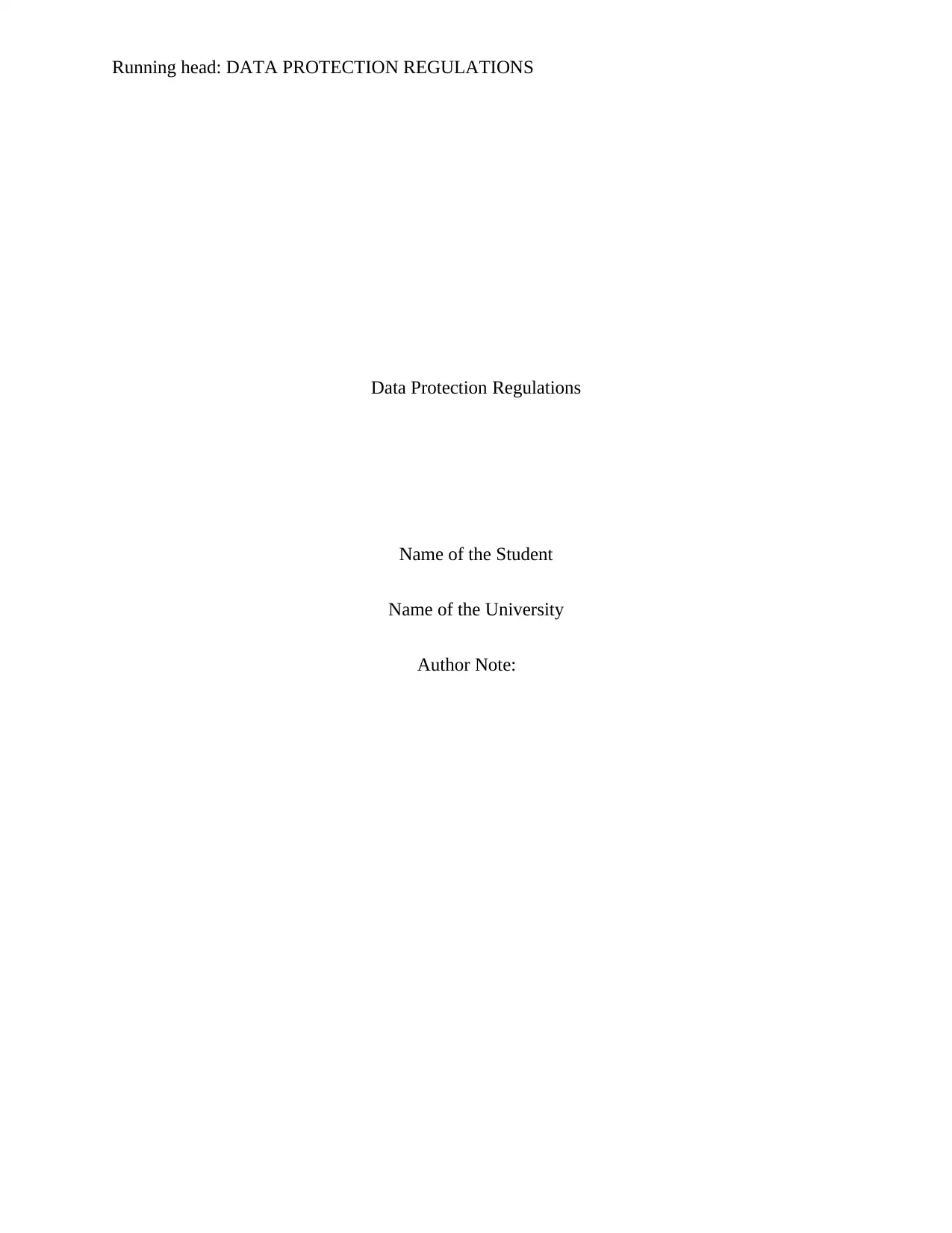
Running head: DATA PROTECTION REGULATIONS
Data Protection Regulations
Name of the Student
Name of the University
Author Note:
Data Protection Regulations
Name of the Student
Name of the University
Author Note:
Paraphrase This Document
Need a fresh take? Get an instant paraphrase of this document with our AI Paraphraser
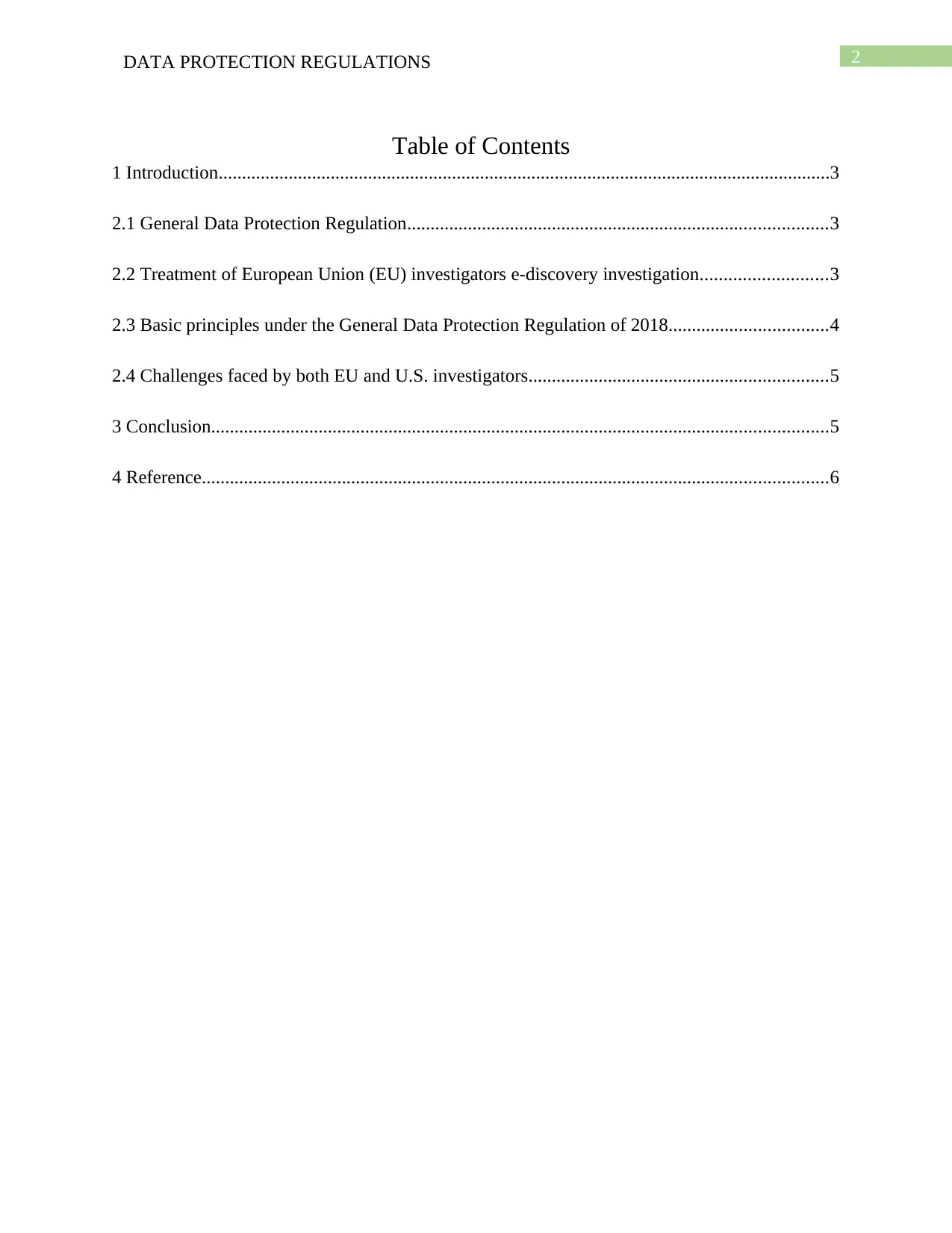
2DATA PROTECTION REGULATIONS
Table of Contents
1 Introduction...................................................................................................................................3
2.1 General Data Protection Regulation..........................................................................................3
2.2 Treatment of European Union (EU) investigators e-discovery investigation...........................3
2.3 Basic principles under the General Data Protection Regulation of 2018..................................4
2.4 Challenges faced by both EU and U.S. investigators................................................................5
3 Conclusion....................................................................................................................................5
4 Reference......................................................................................................................................6
Table of Contents
1 Introduction...................................................................................................................................3
2.1 General Data Protection Regulation..........................................................................................3
2.2 Treatment of European Union (EU) investigators e-discovery investigation...........................3
2.3 Basic principles under the General Data Protection Regulation of 2018..................................4
2.4 Challenges faced by both EU and U.S. investigators................................................................5
3 Conclusion....................................................................................................................................5
4 Reference......................................................................................................................................6
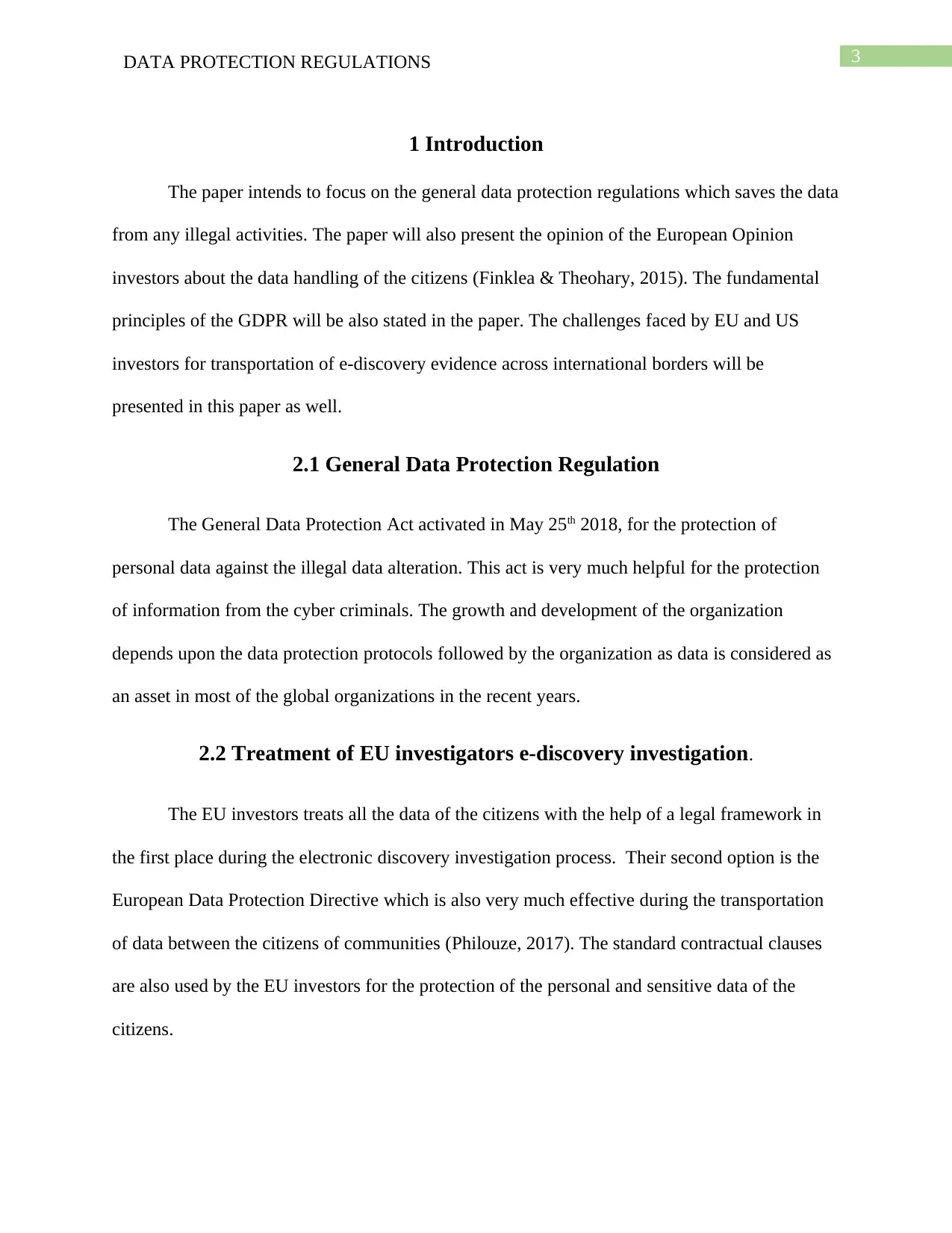
3DATA PROTECTION REGULATIONS
1 Introduction
The paper intends to focus on the general data protection regulations which saves the data
from any illegal activities. The paper will also present the opinion of the European Opinion
investors about the data handling of the citizens (Finklea & Theohary, 2015). The fundamental
principles of the GDPR will be also stated in the paper. The challenges faced by EU and US
investors for transportation of e-discovery evidence across international borders will be
presented in this paper as well.
2.1 General Data Protection Regulation
The General Data Protection Act activated in May 25th 2018, for the protection of
personal data against the illegal data alteration. This act is very much helpful for the protection
of information from the cyber criminals. The growth and development of the organization
depends upon the data protection protocols followed by the organization as data is considered as
an asset in most of the global organizations in the recent years.
2.2 Treatment of EU investigators e-discovery investigation.
The EU investors treats all the data of the citizens with the help of a legal framework in
the first place during the electronic discovery investigation process. Their second option is the
European Data Protection Directive which is also very much effective during the transportation
of data between the citizens of communities (Philouze, 2017). The standard contractual clauses
are also used by the EU investors for the protection of the personal and sensitive data of the
citizens.
1 Introduction
The paper intends to focus on the general data protection regulations which saves the data
from any illegal activities. The paper will also present the opinion of the European Opinion
investors about the data handling of the citizens (Finklea & Theohary, 2015). The fundamental
principles of the GDPR will be also stated in the paper. The challenges faced by EU and US
investors for transportation of e-discovery evidence across international borders will be
presented in this paper as well.
2.1 General Data Protection Regulation
The General Data Protection Act activated in May 25th 2018, for the protection of
personal data against the illegal data alteration. This act is very much helpful for the protection
of information from the cyber criminals. The growth and development of the organization
depends upon the data protection protocols followed by the organization as data is considered as
an asset in most of the global organizations in the recent years.
2.2 Treatment of EU investigators e-discovery investigation.
The EU investors treats all the data of the citizens with the help of a legal framework in
the first place during the electronic discovery investigation process. Their second option is the
European Data Protection Directive which is also very much effective during the transportation
of data between the citizens of communities (Philouze, 2017). The standard contractual clauses
are also used by the EU investors for the protection of the personal and sensitive data of the
citizens.
⊘ This is a preview!⊘
Do you want full access?
Subscribe today to unlock all pages.

Trusted by 1+ million students worldwide
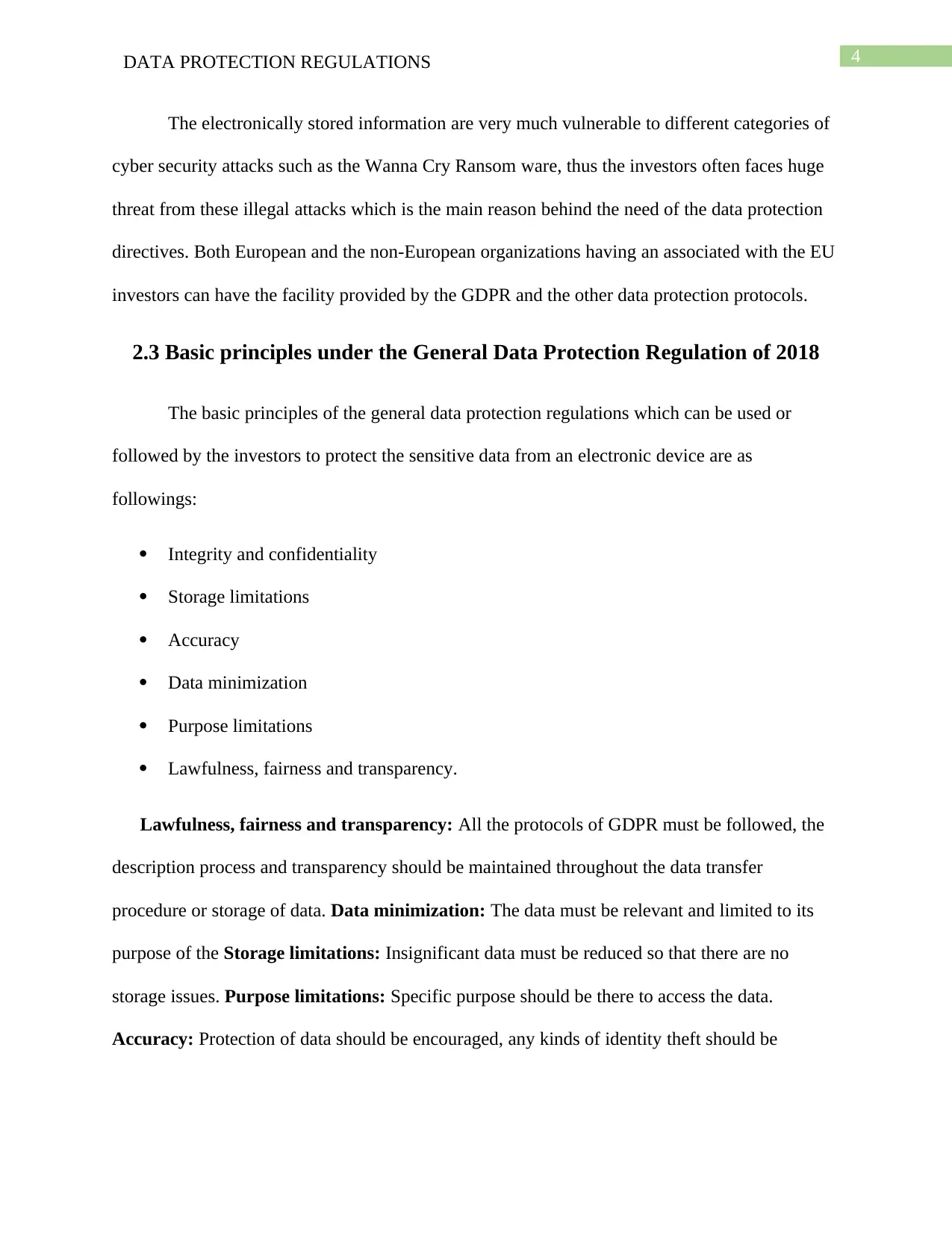
4DATA PROTECTION REGULATIONS
The electronically stored information are very much vulnerable to different categories of
cyber security attacks such as the Wanna Cry Ransom ware, thus the investors often faces huge
threat from these illegal attacks which is the main reason behind the need of the data protection
directives. Both European and the non-European organizations having an associated with the EU
investors can have the facility provided by the GDPR and the other data protection protocols.
2.3 Basic principles under the General Data Protection Regulation of 2018
The basic principles of the general data protection regulations which can be used or
followed by the investors to protect the sensitive data from an electronic device are as
followings:
Integrity and confidentiality
Storage limitations
Accuracy
Data minimization
Purpose limitations
Lawfulness, fairness and transparency.
Lawfulness, fairness and transparency: All the protocols of GDPR must be followed, the
description process and transparency should be maintained throughout the data transfer
procedure or storage of data. Data minimization: The data must be relevant and limited to its
purpose of the Storage limitations: Insignificant data must be reduced so that there are no
storage issues. Purpose limitations: Specific purpose should be there to access the data.
Accuracy: Protection of data should be encouraged, any kinds of identity theft should be
The electronically stored information are very much vulnerable to different categories of
cyber security attacks such as the Wanna Cry Ransom ware, thus the investors often faces huge
threat from these illegal attacks which is the main reason behind the need of the data protection
directives. Both European and the non-European organizations having an associated with the EU
investors can have the facility provided by the GDPR and the other data protection protocols.
2.3 Basic principles under the General Data Protection Regulation of 2018
The basic principles of the general data protection regulations which can be used or
followed by the investors to protect the sensitive data from an electronic device are as
followings:
Integrity and confidentiality
Storage limitations
Accuracy
Data minimization
Purpose limitations
Lawfulness, fairness and transparency.
Lawfulness, fairness and transparency: All the protocols of GDPR must be followed, the
description process and transparency should be maintained throughout the data transfer
procedure or storage of data. Data minimization: The data must be relevant and limited to its
purpose of the Storage limitations: Insignificant data must be reduced so that there are no
storage issues. Purpose limitations: Specific purpose should be there to access the data.
Accuracy: Protection of data should be encouraged, any kinds of identity theft should be
Paraphrase This Document
Need a fresh take? Get an instant paraphrase of this document with our AI Paraphraser

5DATA PROTECTION REGULATIONS
discouraged. Integrity and confidentiality: Accidental loss of data or damage to data should be
stopped in the first place.
discouraged. Integrity and confidentiality: Accidental loss of data or damage to data should be
stopped in the first place.
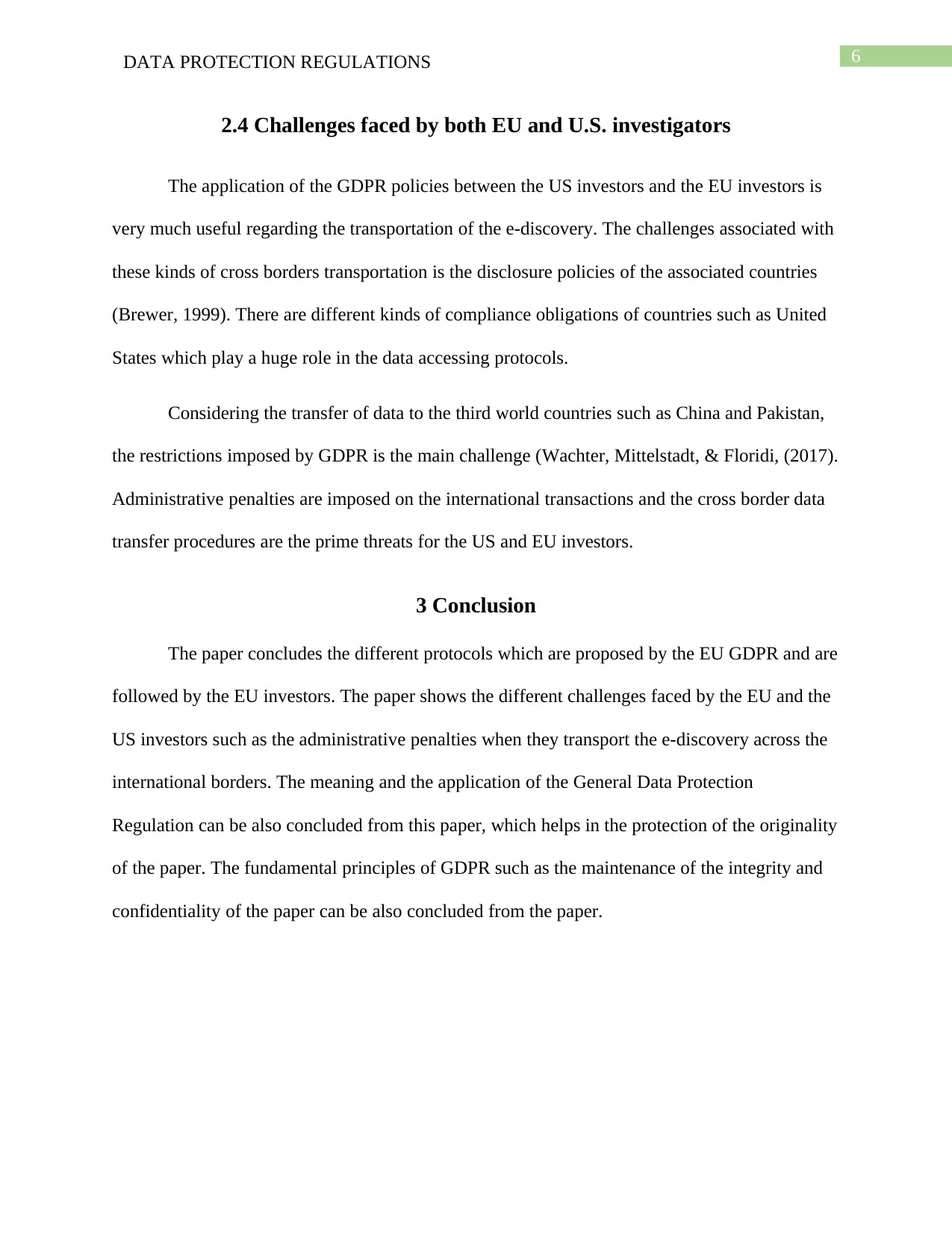
6DATA PROTECTION REGULATIONS
2.4 Challenges faced by both EU and U.S. investigators
The application of the GDPR policies between the US investors and the EU investors is
very much useful regarding the transportation of the e-discovery. The challenges associated with
these kinds of cross borders transportation is the disclosure policies of the associated countries
(Brewer, 1999). There are different kinds of compliance obligations of countries such as United
States which play a huge role in the data accessing protocols.
Considering the transfer of data to the third world countries such as China and Pakistan,
the restrictions imposed by GDPR is the main challenge (Wachter, Mittelstadt, & Floridi, (2017).
Administrative penalties are imposed on the international transactions and the cross border data
transfer procedures are the prime threats for the US and EU investors.
3 Conclusion
The paper concludes the different protocols which are proposed by the EU GDPR and are
followed by the EU investors. The paper shows the different challenges faced by the EU and the
US investors such as the administrative penalties when they transport the e-discovery across the
international borders. The meaning and the application of the General Data Protection
Regulation can be also concluded from this paper, which helps in the protection of the originality
of the paper. The fundamental principles of GDPR such as the maintenance of the integrity and
confidentiality of the paper can be also concluded from the paper.
2.4 Challenges faced by both EU and U.S. investigators
The application of the GDPR policies between the US investors and the EU investors is
very much useful regarding the transportation of the e-discovery. The challenges associated with
these kinds of cross borders transportation is the disclosure policies of the associated countries
(Brewer, 1999). There are different kinds of compliance obligations of countries such as United
States which play a huge role in the data accessing protocols.
Considering the transfer of data to the third world countries such as China and Pakistan,
the restrictions imposed by GDPR is the main challenge (Wachter, Mittelstadt, & Floridi, (2017).
Administrative penalties are imposed on the international transactions and the cross border data
transfer procedures are the prime threats for the US and EU investors.
3 Conclusion
The paper concludes the different protocols which are proposed by the EU GDPR and are
followed by the EU investors. The paper shows the different challenges faced by the EU and the
US investors such as the administrative penalties when they transport the e-discovery across the
international borders. The meaning and the application of the General Data Protection
Regulation can be also concluded from this paper, which helps in the protection of the originality
of the paper. The fundamental principles of GDPR such as the maintenance of the integrity and
confidentiality of the paper can be also concluded from the paper.
⊘ This is a preview!⊘
Do you want full access?
Subscribe today to unlock all pages.

Trusted by 1+ million students worldwide
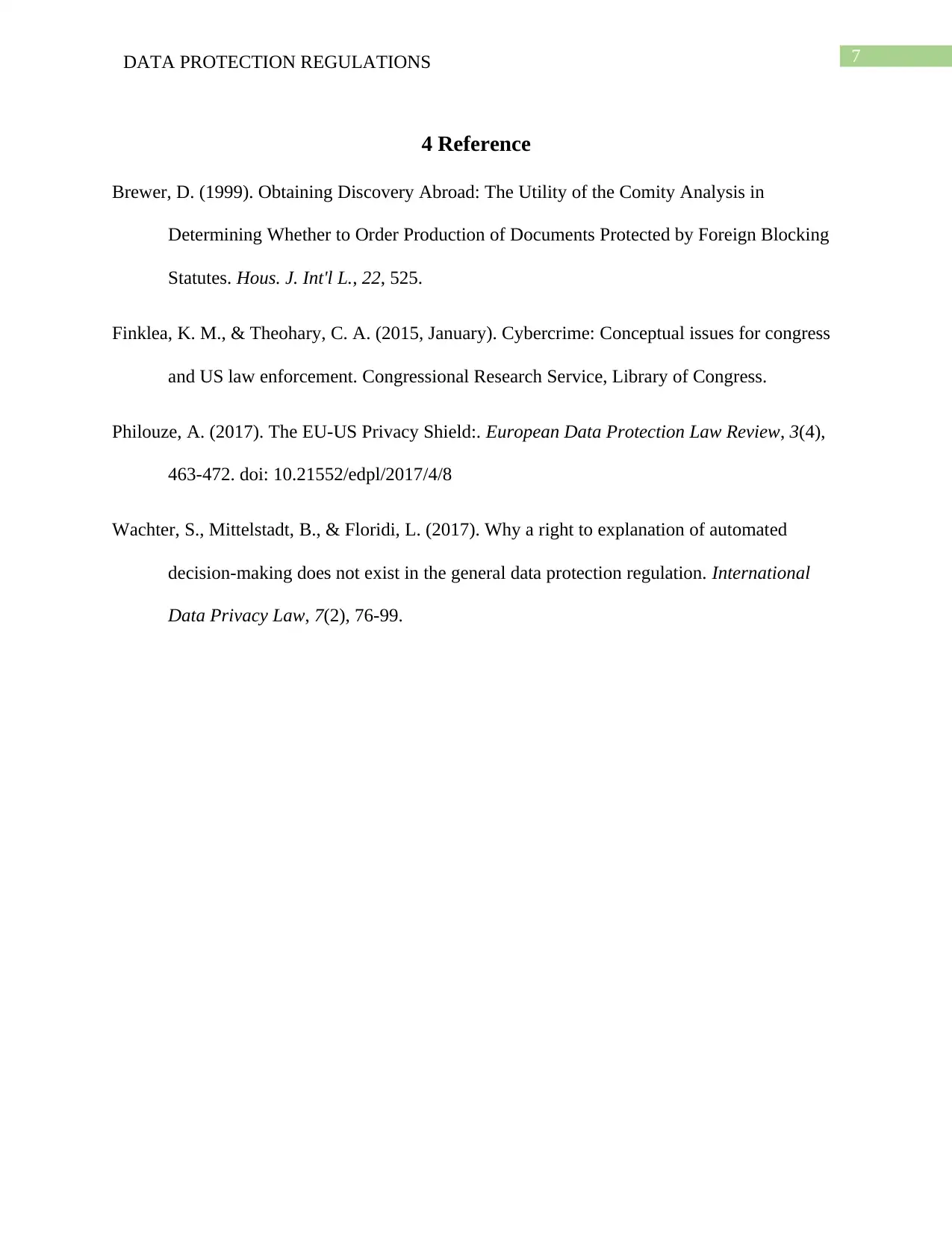
7DATA PROTECTION REGULATIONS
4 Reference
Brewer, D. (1999). Obtaining Discovery Abroad: The Utility of the Comity Analysis in
Determining Whether to Order Production of Documents Protected by Foreign Blocking
Statutes. Hous. J. Int'l L., 22, 525.
Finklea, K. M., & Theohary, C. A. (2015, January). Cybercrime: Conceptual issues for congress
and US law enforcement. Congressional Research Service, Library of Congress.
Philouze, A. (2017). The EU-US Privacy Shield:. European Data Protection Law Review, 3(4),
463-472. doi: 10.21552/edpl/2017/4/8
Wachter, S., Mittelstadt, B., & Floridi, L. (2017). Why a right to explanation of automated
decision-making does not exist in the general data protection regulation. International
Data Privacy Law, 7(2), 76-99.
4 Reference
Brewer, D. (1999). Obtaining Discovery Abroad: The Utility of the Comity Analysis in
Determining Whether to Order Production of Documents Protected by Foreign Blocking
Statutes. Hous. J. Int'l L., 22, 525.
Finklea, K. M., & Theohary, C. A. (2015, January). Cybercrime: Conceptual issues for congress
and US law enforcement. Congressional Research Service, Library of Congress.
Philouze, A. (2017). The EU-US Privacy Shield:. European Data Protection Law Review, 3(4),
463-472. doi: 10.21552/edpl/2017/4/8
Wachter, S., Mittelstadt, B., & Floridi, L. (2017). Why a right to explanation of automated
decision-making does not exist in the general data protection regulation. International
Data Privacy Law, 7(2), 76-99.
1 out of 7
Related Documents
Your All-in-One AI-Powered Toolkit for Academic Success.
+13062052269
info@desklib.com
Available 24*7 on WhatsApp / Email
![[object Object]](/_next/static/media/star-bottom.7253800d.svg)
Unlock your academic potential
Copyright © 2020–2025 A2Z Services. All Rights Reserved. Developed and managed by ZUCOL.





